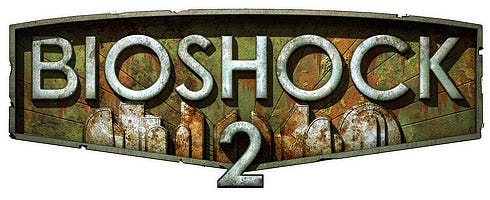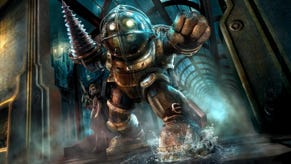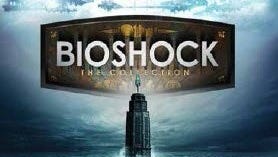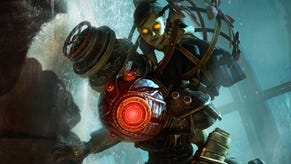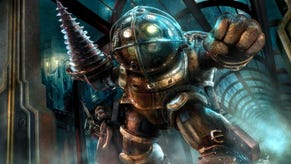Hands-on with BioShock 2 in London
We were recently lucky enough to get play-time with the latest build of BioShock 2 in London. We sent Simon Parkin along to see whether or not 2K Marin's monster effort is worthy of Levine's original dream.
In the ten years that separate the end of Bioshock from the beginning of its sequel, the underwater city of Rapture has deteriorated. It’s not that the place has necessarily decayed, though the art deco signage and once plush 1930’s fixtures and fittings exhibit perhaps a little more wear, tear and gunshot wounds than before. Rather, it's those inhabitants that roam its deep-sea corridors who have worsened with the passing of time, their hellish mutations accelerated yet further by another decade’s worth of substance abuse.
ADAM, the curious, DNA-altering essence extracted from sea slugs and injected into the veins of Rapture’s bored and disillusioned citizens, has diversified and toughened the city’s monstrous population in terrible ways. If Bioshock was about the utopia project turned to dystopian ruin, then Bioshock 2 examines what happens when dystopias descend to hells. 2K Marin is quick to point out that Jack, the brawny but essentially human protagonist from the first game, simply would not survive in this cruel new world of heroin-chic splicers and ethically-bankrupt scientists.
So perhaps it’s just as well that this time around, you play not as a plane crash survivor who stumbles serendipitously into Rapture’s depths, but rather a prototype Big Daddy, one of the hulking creatures – part oversized diver, part portable drill bit – who plod its network of underwater tunnels. Known only as Subject Delta, your character has become separated from his little sister, one of the waif-like girls who accompany each Big Daddy around Rapture harvesting ADAM from its dead and dying citizens. Subject Delta has gained sentience and, importantly, a free will of his own. Unshackled from the whims of his creator, you’re free from the relentless task of hunting ADAM; free, if 2k Marin are to be believed, to become whoever you choose to become.
That said, Bioshock 2’s overarching objective is immovable: to locate your little sister, who is promising escape from Rapture, provided you can reach her. Between you and your unlikely saviour sits a veritable army of splicers and ferocious Big Daddies, many of whom are in service to the game’s all new arch-villainess, Dr Sophia Lamb. Lamb is an unflinching altruist, the ideological opposite to Andrew Ryan, the architect of Rapture, who has seized control of the city and is trying to improve it with every scrap of her energy. While that dream may seem admirable, Lamb has no qualms with eliminating any threat to her singular communistic vision, and a sentient Big Daddy with free will who ignores her every command is nothing if not a threat. The result of this narrative premise is a sharpening of the game’s focus, one that benefits the experience from its opening moments.
In mechanical terms, the Bioshock experience has received a dramatic overhaul, particularly in terms of its competence as a first person shooter. You now dual wield, a weapon in your right hand, a plasmid (one of Bioshock’s steampunk-esque special tools) in your left. The decision results in a far more slick combat experience, eliminating the need to freeze the game and root around menus to pull out the ability you’re looking for. Rather you can cycle between weapons and plasmids at the touch of a button, adjusting your tools to suit the required approach in any face off with the game’s enemies. Now it’s easy to riddle a splicer with bullets before freezing them mid-air as they leap towards you, only to see them shatter as they fall to the ground. Splicers are now cover aware and will duck behind walls and pillars at the correct heights to avoid your fire. As a result the resistance to your movements feels better orchestrated and organized, and, while the difficulty may not have necessarily increased, the challenge feels more rounded and believable than it previously did.
The plasmid system has also undergone something of a rebirth. Now, many of the abilities you unlock upgrade with your character, unlocking new discrete abilities as you invest in them at Plasmid stations. Upgrade the Security Man ability, for example, and you will be able to summon a friendly security bot to provide back up at will. Likewise, every weapon in the game boasts four Farcry 2-style augmentations, each radically changing its tactical potential. Moreover, weapons can be used more creatively in holding back the horde. For example, instead of merely using the rivet gun to pin splicers to nearby walls, you can aim it at the ground and use the spikes to create impromptu fences, multiplying the strategic options in any given situation. In play, Bioshock 2 seems far more customizable than its predecessor, although whether this raft of options manages to balance out over the course of the experience remains to be seen.
Security cameras, many of which are hooked up to chain guns, once again, plague the city. Whereas in the first game, play was frequently interrupted by an enjoyable, if ultimately repetitive hacking minigame, now it’s possible to hack into terminals, bots and cameras mid-combat. Selecting to hack an object brings up a timing-style minigame in the HUD, in which you must press buttons to stop a needle in the correct zone as it scrolls up and down a gauge. Stopping the needle in the green zone will make the object work for you. Stopping it in the blue zone (a smaller and tougher area to hit) improves the functionality of the machine, making, for example, an alarm last for longer or the robot perform more damage.
As with the first game, much emphasis is placed on Rapture’s Little Sisters. Defeat a rival Big Daddy and, once again, you must decide how to treat its accompanying handmaiden, by either harvesting her body for ADAM or, alternatively ‘adopting’ them to your cause. Choose to adopt and she’ll climb onto your shoulders (you are a Big Daddy, and so trustworthy after all). At the click of a button she’ll lay a Fable 2-style light crumb trail that leads to the nearest dead body containing ADAM. Once a little sister has been used to locate an area’s ADAM-rich corpse, you can either choose to either betray her blind daughter-like trust and harvest her or, alternatively, free her from the abusive harvesting system once and for all.
To make this decision a more difficult one than it was in the first game, Bioshock 2 introduces Big Sisters, the most powerful enemies in the game. Free too many Little Sisters and a Big Sister will sense their removal from the ‘economy’, and make a beeline through Rapture on your position, a powerful disincentive against always playing the good guy that ensures the decision to release any young ‘un is a weighty one.
As the game progresses so you’ll begin to encounter some of Rapture’s more idiosyncratic citizens face-to-face, engaging with third parties in ways other than those simply be expressed down the barrel of a gun. 2K Marin is eager to point out that these meetings radically shape the way that your particular story plays out, reinforcing the themes of freewill that thread through the game. Whether this means branching narrative paths, or more organic ways of expressing repercussions of player choices is unclear at this stage.
While Bioshock 2 revisits some of the areas seen in the first game, many of the environments are entirely new to the player, exploring previously unseen areas of the Rapture utopia project. From the red light district of Siren Alley, a New Orleans style street filled with the harrowed ghosts of prostitutes past, to the ostensibly wholesome museum so Bioshock 2’s environments are rich and diverse. The areas we saw perfectly complemented the template laid out by the first game, while also managing to broaden it in interesting ways. Nooks and crannies spread like tendrils from every area and the game appears to reward exploration off the beaten track. Every area is infused with a sense of historical narrative with, for example, the makeshift church of Father Wales is scattered with syringes held in glass cabinets like Catholic relics, its walls daubed with pro-Plasmid slogans and dogma that reveal the state of the minds that frequent the place.
As the game enters its final crunch, it’s clear that 2K Marin has been working hard to broaden and deepen both the story of Bioshock, as well as its experience as a role-playing shooter. This sequel appears to offer a compelling new vision for those players of the first game convinced by Ken Levine’s storytelling but left cold by the developer’s attempts to create a deep ad engaging shooter. But there’s no denying that this is evolution rather than revolution, a sequel designed to delight those enraptured by the Bioshock mythology and vision. It may smooth over the niggles that left some lukewarm to the first game, but whether its innovations are bold enough to convert its vociferous detractors seems pretty unlikely at this late stage.
